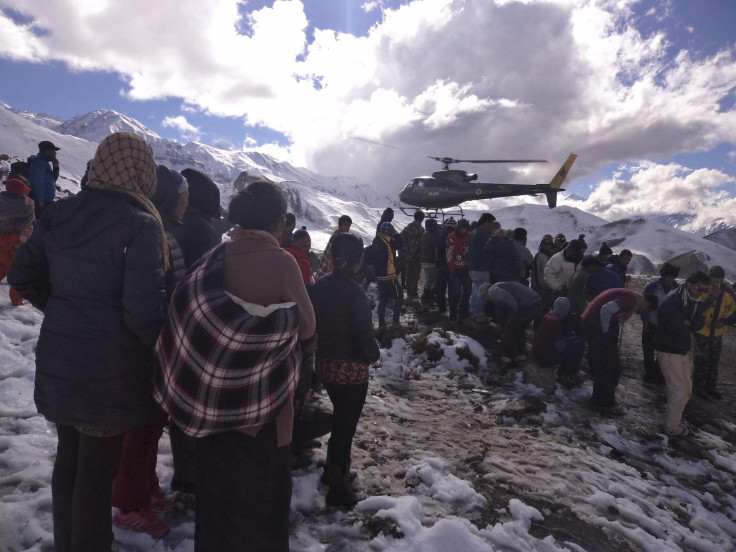Trekking Tragedy Shakes Nepal's Faith In Shoestring Tourism

KATHMANDU (Reuters) - German tourist Tobias Pantel is determined to leave soon on a five-day hike in the Annapurna region, the very place where dozens were killed by a freak blizzard and avalanches in Nepal's most deadly trekking disaster.
As the search for dozens still missing on the snow-covered Himalayan slopes continues and relatives around the world wait in desperation for news of their loved ones, more foreigners are preparing to hit the trail.
"It was a natural accident that could take place anywhere," said Pantel as she sat outside a Kathmandu hotel, sipping beer and smoking with her husband. "I want to go to the area because it is very beautiful. I don't think the storm will come next time."
Every year, thousands of adventure tourists like Pantel set out on treks in the spectacular heights around Annapurna, the world's tenth-highest peak. But many have little or no previous experience on mountains, and many are young backpackers who are cavalier about the risks and tend not to hire trained guides.
Now, even as it faces a barrage of criticism for failing to warn trekkers about the storm rolling in, Nepal's government is having doubts about its thousands of shoestring-budget tourists.
"It is better to have less tourists who pay more than thousands who come but flout rules," said the tourism ministry's joint secretary, Mohan Krishna Sapkota.
He said many of the trekkers who were on the Annapurna circuit when the weather turned hostile had not registered in advance with the authorities, and this meant there was no reliable record for rescuers of who and how many were up there.
"This will not be tolerated anymore," he told Reuters.
Such an idea may be unworkable, though, with one critic warning any restrictions would hurt an economy heavily reliant on tourism and another questioning the logic given plans to open new routes to trekkers.
"They are opening new peaks to foreign climbers, so where is the question of limiting anyone?" said U.S. national Elizabeth Hawley, who has lived in Nepal since 1960 and chronicles major mountain expeditions.
Since the Oct. 13 storm, the army has pulled 30 corpses out of thick snow and was expecting to collect nine more on Sunday. Nepalese, Israeli, Canadian, Indian, Japanese, Slovak and Polish trekkers are among the dead.
The Annapurna Conservation Area Project (ACAP), a government body that registers the entry and exit of tourists in the north-western ranges of Nepal, said it had records of only 120 tourists on the trekking route when the blizzard hit.
But more than 400 people have been brought to safety, and helicopters are scouring the area for more than 60 others rescuers believe may still be up there.
"We had no idea that so many people were trekking there," said ACAP officer Junu Thapa. "Foreign tourists should register and not venture out on their own with local boys who pretend to be professional guides."
An army official involved in the rescue operation said some trekkers were found off the beaten track with no local guide.
"Some backpackers were not carrying proper winter clothes with them and had covered themselves in plastic sheets to stay warm," said the official, who asked not to be named. "Why should the government allow anyone to trek if the tourists are not well equipped?"
"IRRESPONSIBLE TOURISM"
Home to over 1,300 peaks, Nepal allows climbing on 414, including Mount Everest, where 16 guides were killed by an ice-avalanche six months ago.
More than 106,000 foreigners visited Nepal in 2012 for trekking and mountaineering, according to government data.
The government, which came under fire last week for failing to issue timely weather warnings, now seems determined to crack down on the "freelance tourism" of unlicensed and inexperienced guides who lead treks for as little as $10 a day.
The tourism ministry's Sapkota believes many tour guides were unprepared for the white-out on the Thorong La pass, which bore the brunt of the unseasonable snowstorm.
"The problem is every young man wants to be a tour guide because the job is exciting and gives them a chance to make money very quickly," he said. "This kind of irresponsible tourism will ruin Nepal's image."
His ministry has now decided to register and track the movements of more than 10,000 Nepali men who work as porters and guides, and make it mandatory for tourists to seek permission from district authorities before starting out on any trek.
Suman Pandey of Explore Himalaya, a company that specializes in organizing treks and climbing snowy peaks, said the government's plan was an "absurd reaction" to the disaster.
"The government will be committing a blunder if they start limiting the entry of backpackers. Even if the backpackers live and travel across the country on less than $15 a day, they still contribute to our economy."
"By making tourism restrictive and expensive, the government will destroy the vibrant industry and ruin our business."
Hawley said she doubted the government would restrict budget tourists.
"They don't want to shoot themselves in the foot," said Hawley, after whom the government recently named a mountain - Peak Hawley - and opened it up to foreign climbers.
"I will not be surprised if this tragic incident is quickly forgotten."
© Copyright Thomson Reuters 2024. All rights reserved.





















